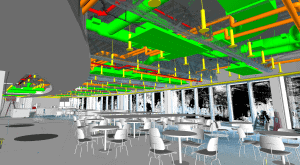According to a recent study conducted by the Commerce Department, spending on private projects in the United States hit a record high of $1.25 trillion last year. A large driver for this boom was the embrace of new innovations and technologies in construction projects. In Boston alone, there are nearly 70 companies focused on construction, real estate technology, and smart cities.
While new trends continue to evolve and reshape our industry, it is important to note that technology will augment, not replace, workers. And despite advances in automation, buildings will continue to be built (largely) by humans. This year, and moving forward, we expect the narrative to reveal the ways technology is empowering — and not replacing —the workforce to do their jobs better.
With the skilled labor shortage showing no signs of slowing down, companies will turn to technology to do more with fewer resources, continuing to hire and train employees to incorporate these innovations into their work. And, ultimately, business development will continue to be propelled by human relationships, and networking connections, as the construction industry finds new opportunities to improve the country’s infrastructure.
While technology and innovation are significant contributors, it’s important to recognize some of the major trends currently influencing the sector.
Internet of Things
Also called IoT, these sensors are being embedded throughout worksites in an attempt to enhance automatic data collection. Smart cities use these sensors, which collect information from a multitude of resources, to enrich the type and quantity of data collected, which will aid in monitoring and control. Cities then use this data to improve infrastructure, public utilities, services, and more. With the more widespread adoption of IoT, insurers are embracing the new technology, and jobsites are gaining security, efficiency, and safety. These devices are a key part of risk management and help improve injury response and to communicate hazardous situations.
Robotics
Robots have begun to enter construction in a number of areas. From autonomous rovers that can increase the efficiency and provide greater detail during site inspections, to mechanical arms that automate highly repetitive tasks such as brick-laying and tying rebar, the robotic revolution is set to gather significant pace in 2019.
While the credibility of robots on live construction sites has long been questioned, these robots are growing even more precise and accurate, and they’ll likely become a commanding force in the construction industry.
Connectivity
Connected jobsites use cloud technology to make information about almost every aspect of their operation available to all the relevant parties, regardless of whether those parties are onsite or elsewhere. From putting design information streamed from a single point of truth into the palms of operatives, to information by geolocation, remote site monitoring, personnel location tracking, live mark-ups, and the seamless transfer of as-built information — connected job sites improve communication, productivity, and safety for everyone involved in a project.
Predictive analytics
Predictive analytics combines techniques like data mining, statistics, and modeling to analyze data and make future predictions. Along with machine learning, systems that not only feed information to the head office, but can also look ahead and provide insight into safety concerns, scheduling, or budget outlooks are going to see increased development and innovation. Predictive analytics combines techniques like data mining, statistics, modeling, machine learning, and artificial intelligence to analyze data and make forecasts. The purpose of predictive analytics is to create a new approach to problem solving through the use of data, predicting patterns in workflow, and highlighting innovative solutions. Predictive systems can anticipate problems as well as opportunities and give project managers insights that contribute to critical decisions.
Expansion of BIM
The process for creating and managing all of the information about a project, leading to an output known as a building information model (BIM), which contains digital descriptions for every aspect of the physical project, brings more accuracy to the building process and enables the exchange of important project information between numerous stakeholders. Moreover, its further evolution is anticipated to make construction projects more productive and affordable by including cutting edge sustainability and information.
Simply put: Many of these innovations underscore the quality of life on the job, and improve the ability of crew members at every level to spend their time and money wisely. We anticipate these tools and technologies will benefit people on a fundamental level moving forward, and expect the future will ensure more breakthroughs centered on accessibility and ease of service to be unveiled in the future.
